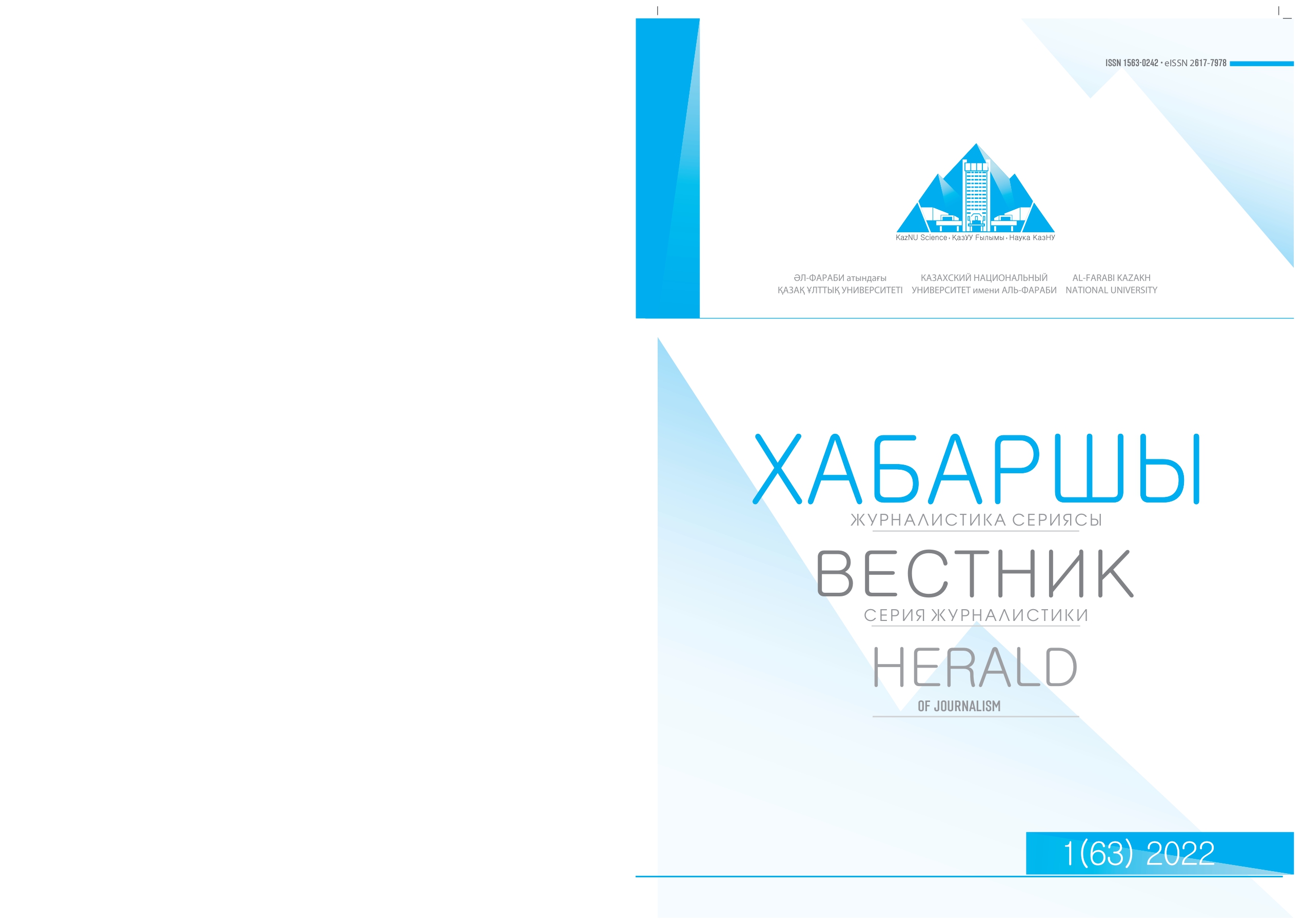The role of using the language of feelings and emotions in mass media texts
DOI:
https://doi.org/10.26577/HJ.2022.v63.i1.05Abstract
This article examines the phenomenon of feeling, defines how it manifests in the linguistic aspect of the person and analyzes the types of emotional aspects found in mass media texts. Research purpose is the comparative study of linguo-cultural characteristics of emotional vocabulary in Kazakh and English. The main goals and objectives of scientific research are as follows: to determine the volume and composition; to define the lexical and semantic features; to reveal the national-cultural function; to determine cultural-national connotation; to address issues of national acculturation of words that express feelings in English and Kazakh mass media texts. The functions of language are considered in conjunction with its sensory functions, the meaning of language as the general tool for this purpose is comprehensively revealed. A person's worldview is defined, different emotional states of feeling, the world of art and the language of national identity are presented. The findings of the study broaden the possibilities for presenting new knowledge of the world through the media. A significant research result is the study process of the features of the expression of feelings and emotions. Research methods used: content analysis, continuous sampling method, method of linguistic analysis. Research value is the importance and scientific significance of comparative analyses in English and Kazakh feelings vocabulary, which is a new and quite promising direction of linguistics. The study of this phenomenon gives writers, poets, linguists, journalists and other creative professionals the prerequisite for the development of feelings vocabulary.
Key words: feeling, emotions, phenomena, mass media texts, language aspects, genres, the notion of feelings.
References
2. Carroll E.Izard. (1991) The Psychology Of Emotions, Springer US,1st ed., p.4
3. Cool English magazine. N 15-20, 2008.
4. Danes F. (1987) Cognition and Emotion in Discourse Interaction: A Preliminary Survey of the Field // Preprints of the Plenary Session papers/ 14th International Congress of Linguists, Berlin, pp.272-291.
5. Diller H.-J.(1992) Emotions and the Linguistics of English, Tubungen, pp.25-29.
6. Gallois C.(1993) The Language and Communication of Emotion: Interpersonal, Intergroup or Universal? , American Behavioral Scientist, V.3.,pp.309-338
7. Goleman D.(1997) Emotional Intelligence. Why it can matter more than IQ?, Bantam Books, p.357
8. Johnson-Laird P.N., Oatley K.(1989) The Language Of Emotions: An Analysis Of Semantic Field \\ Cognition And Emotion., V.3, pp.81-123.
9. Joan McCormack and Sebastian Watkins. (2009) English for academic study: Speaking. University of Reading, p.127
10. Michael McCarthy, Felicity O’Dell (2002) English Vocabulary in Use. Advanced, Cambridge University Press, p.315
11. https://jasqazaq.kz/2017/05/13/atyn-zh-ne-jel-s-zderini-ajsysyn-oldan-an-d-rys/
12. Witte M. Steppe Sisters: Kazakhstan’s Rising Women Politicans. Сайт журнала «Edge.kz» [Электронный ресурс] – Режим доступа: www.edgekz.com/steppe-sisters-kazakhstans-rising-women-politicans/ [26.10.15].
13. Witte M. Beshbarmak: Five Finger Food. Сайтжурнала «Edge.kz» [Электронныйресурс] – Режимдоступа: www.edgekz.com/ beshbarmak-five- finger-food/ [26.10.15].
14. Арнольд И.В. (1975) Интерпретация художественного текста: типы выдвижения и проблемы экспрессивности, Экспрессивные средства английского языка, стр.11-20
15. ‘Әлпейісова К. Мағналас мақал-мәтелдердің, қанатты сөздердің қазақша орысша және орысша-қазақша сөздігі. – Астана: Аударма, 2006. – 168 бет.
16. Костомаров В.Г.(1965) Из наблюдении над языком газеты: Газетные заголовки. М.:Мысль,163-181стр
17. Серғалиев М.С.(1997) Кейбір стилистикалық ұғымдар мен категориялар туралы,ҚазМУ Хабаршысы, Филология сериясы, 4-9бб
18. Смағұлова Г.Н. (1999) Бұқаралық ақпарат құралдары тілінің ұлт менталитетіне әсері, Астана: Тілдерді дамыту департаменті, 360-370бб
19. Сыздық Р. (1997) Сөз құдіреті, Алматы: Санат, 224б
References:
1. Aitchison J. (1987) Words in the mind: an introduction to the mental lexicon, Oxford: Basil Blackwell, p.158.
2. Carroll E.Izard. (1991) The Psychology Of Emotions, Springer US,1st ed., p.4
3. Cool English magazine. N 15-20, 2008.
4. Danes F. (1987) Cognition and Emotion in Discourse Interaction: A Preliminary Survey of the Field // Preprints of the Plenary Session papers/ 14th International Congress of Linguists, Berlin, pp.272-291.
5. Diller H.-J.(1992) Emotions and the Linguistics of English, Tubungen, pp.25-29.
6. Gallois C.(1993) The Language and Communication of Emotion: Interpersonal, Intergroup or Universal? , American Behavioral Scientist, V.3.,pp.309-338
7. Goleman D.(1997) Emotional Intelligence. Why it can matter more than IQ?, Bantam Books, p.357
8. Johnson-Laird P.N., Oatley K.(1989) The Language Of Emotions: An Analysis Of Semantic Field \\ Cognition And Emotion., V.3, pp.81-123.
9. Joan McCormack and Sebastian Watkins. (2009) English for academic study: Speaking. University of Reading, p.127
10. Michael McCarthy, Felicity O’Dell (2002) English Vocabulary in Use. Advanced, Cambridge University Press, p.315
11. https://jasqazaq.kz/2017/05/13/atyn-zh-ne-jel-s-zderini-ajsysyn-oldan-an-d-rys/
12. Witte M. Steppe Sisters: Kazakhstan’s Rising Women Politicans. Web-journal "Edge.kz " [Electronic resource] - Access mode: www.edgekz.com/steppe-sisters-kazakhstans-rising-women-politicans / [10/26/15].
13. Witte M. Beshbarmak: Five Finger Food. Web-journal "Edge.kz " [Electronic Resource] - Access Mode: www.edgekz.com / beshbarmak-five- finger-food/ [10/26/15].
14. Arnol`d I.V. (1975) Interpretacziya khudozhestvennogo teksta: tipy` vy`dvizheniya i problemy` e`kspressivnosti, E`kspressivny`e sredstva anglijskogo yazy`ka [Interpretation of Literary Text: Types of Proposal and Problems of Expressiveness, Expressive Means of the English Language], str.11-20
15. Alpeisova K. Magnalas makal-matelderdin, kanatty sozderdin kazaksha orysha zhane orysha-kazaksha sozdigi. - Astana: Audarma, 2006– - 168 bet.
16. Kostomarov V.G. (1965) Iz nablyudenii nad yazikom gazeti:gazetniye zagolovki [From an observation on newspaper language: Newspaper headlines], M:Mysl’, pp.163-181
17. Sergaliyev M.S.(1997) Keibir stilistikalik ugimdar men kategoriyalar turali [About some stylistic concepts and categories], KazMu Khabarshysy. Philologiya seriyasi, pp.4-9
18. Smagulova G.,(1999) Bukaralyk akparat kuraldari tilinin ult mentalitetine aseri [The influence of the language of the media on the mentality of the nation], Astana: Tilderdi damitu departamenti, pp.360-370
19. Syzdyk R. (1997)Soz kudireti [The power of words], Almaty: Sanat, p.224




